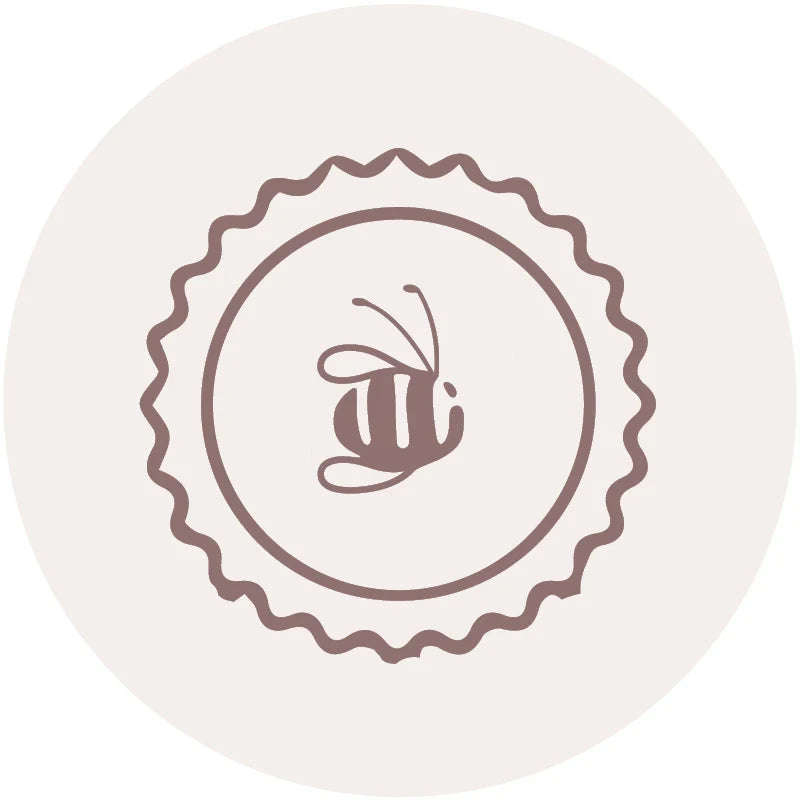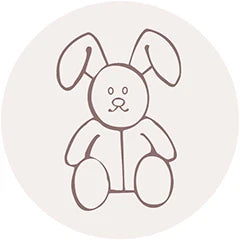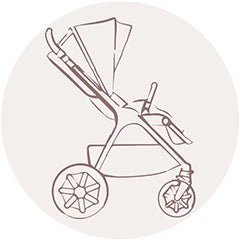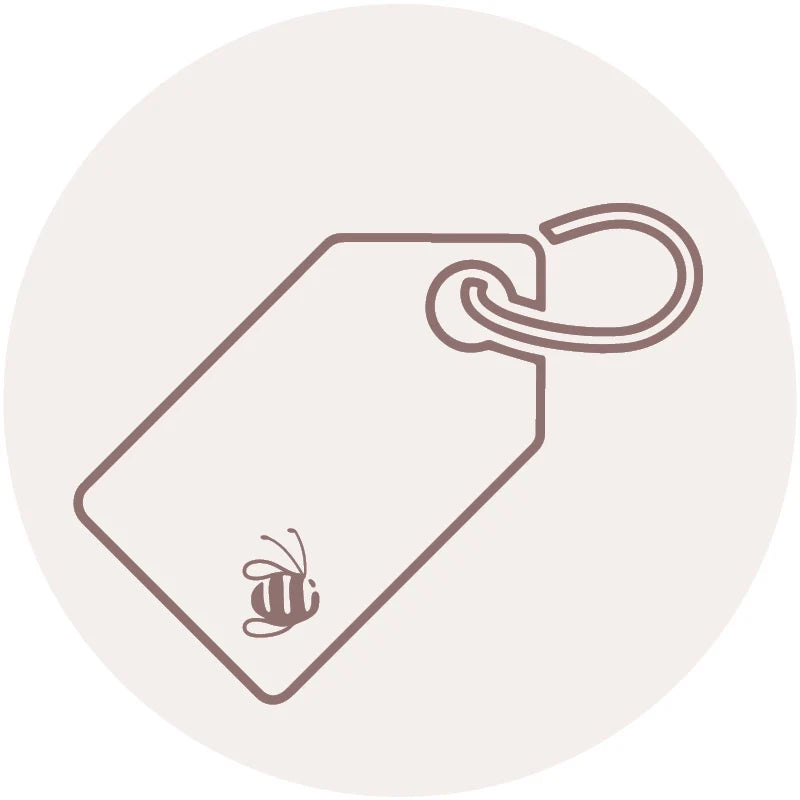Baby Feeder
Baby Feeder
SKU:4350250
Clothing Prem to 18 Months
| Size | Age Guide | Weight | Height |
|---|---|---|---|
| Premature | Premature or Small Newborn | Up to 4Kg | Up to 55cm |
| Newborn | 0-3 months | 4-6Kg | Up to 62cm |
| 3 Month | 3-6 months | 6-8Kg | Up to 68cm |
| 6 Month | 6-12 Month | 8-10Kg | Up to 76cm |
| 12 Month | 12-18 Month | 10-12Kg | Up to 84cm |
| 18 Month | 18-24 Month | 12-14Kg | Up to 92cm |
Clothing 2 to 6 Years
| Size | Age Guide | Height | Chest | Waist | Hip |
|---|---|---|---|---|---|
| 2 Year | 2-3 Years | Up to 100 cm | 56 | 51 | 58 |
| 3 Year | 3-4 Years | Up to 105 cm | 58 | 53 | 60 |
| 4 Year | 4-5 Years | Up to 110 cm | 60 | 55 | 62 |
| 5 Year | 5-6 Years | Up to 115 cm | 62 | 57 | 64 |
| 6 Year | 6-7 Years | Up to 120 cm | 64 | 59 | 66 |
Beanie Size Guide
| Size | Head Circumference | Age Guide |
|---|---|---|
| Premature | 31-35 cm | Premature or Small Newborn |
| Newborn | 35-40 cm | Newborn |
| Small | 40-43 cm | 3-6 Months |
| Medium | 43-47 cm | 6-18 Months |
| Large | 47-52 cm | 18-3 Years |
Sunhat Size Guide
| Size | Head Circumference | Age Guide |
|---|---|---|
| Newborn | 37-40 cm | Newborn |
| Small | 40-43 cm | 3-6 Months |
| Medium | 43-46 cm | 6-12 Months |
| Large | 46-49 cm | 12-24 Months |
| Xtra Large | 49-54 cm | 2-4 Years |
Sleep Pods Size Guide
| Size | Weight | Age Guide | Measurement(Back to Hem) |
|---|---|---|---|
| Newborn | 0-6 kgs | 0-3 Months | 60.5 cm |
| Small | 0-8 kgs | 3-6 Months | 66 cm |
Booties Size Guide
| Size | Age Guide |
|---|---|
| Newborn | 0-3 Months |
| Small | 3-6 Months |
| Medium | 6-12 Months |
| Large | 12-18 Months |
Pretty Brave Baby
| Foot Length (mm) | Insole Length (mm) | EU | UK | Age | INT |
|---|---|---|---|---|---|
| 95-104 | 110 | 16/17 | 2 | 0-6m | S |
| 104-114 | 118 | 18 | 3 | 6-12m | M |
| 114-123 | 127 | 19/20 | 4.5 | 12-18m | L |
| 123-137 | 142 | 21/22 | 5.5 | 16-22m | XL |
Pretty Brave 1st Walker
| Foot Length (mm) | Insole Length (mm) | EU | UK | Age |
|---|---|---|---|---|
| 114-120 | 125-128 | 19 | 3 | 1 yr |
| 120-126 | 132-135 | 20 | 3.5 | 1-2 yrs |
| 126-132 | 138.5-141.5 | 21 | 4.5 | 1-2 yrs |
| 132-138 | 145-148.5 | 22 | 5 | 2 yrs |
Crywolf Swim Nappy
| Size | Length (waist to crotch) | Crotch Width (side to side) |
|---|---|---|
| 0-1 yr | 1-2 yrs | |
| 37 | 38 | |
| 14.5 | 15.5 |
Crywolf Rash Suit
| Size | Length (back neck to crotch) | Chest (arm to arm) | Waist (side to side) | Sleeve (neck to cuff) | Neck Opening(diameter) |
|---|---|---|---|---|---|
| 6-12 Months | 1 yr | 2 yrs | 3 yrs | ||
| 40 | 42 | 44 | 46 | ||
| 25 | 26 | 27 | 28 | ||
| 24 | 25 | 26 | 27 | ||
| 30 | 31.5 | 33 | 34.5 | ||
| 13.25 | 13.25 | 13.8 | 14.3 |
Low stock
Couldn't load pickup availability
Overview
Overview
Help your little one explore new flavors safely with the Baby Feeder – your go to tool for smooth, stress free weaning.
Designed with a soft silicone nibble pouch, it’s perfect for introducing fruits, veggies, or even frozen breast milk and formula (great for summer!).
The feeder allows babies to self feed while reducing the risk of choking, making snack time both fun and safe. The clever design helps your baby discover new tastes while soothing tender gums during teething.
What's Included
What's Included
Key Features
Key Features
User Guide
User Guide
Delivery and Returns
Delivery and Returns
- Delivery: Free within NZ on orders over $100 (excluding bulky items) or $8 standard shipping
- Returns: Accepted within 14 days of receipt with proof of purchase
- Some items are excluded from returns including sale items, hardware, car seats, prams, monitors and personal items - please click here for the full list.
Share this product
Recently Viewed Products
Related Blogs
Music for Babies
Is it a myth or a must? You may have heard that Mozart in utero is essential to healthy brain development, and Baby Einstein on repeat will produce an intellectually advanced toddler. But is music for babies really a thing? Exposing babies and toddlers to music might not necessarily be intelligence-inducing, but it definitely has its benefits for both parents and babies. Here’s what the science really says! Music in utero From around 20 weeks into pregnancy, your baby’s ears start functioning – taking in all the familiar and soothing sounds of the womb and the outside world. That might be mum’s favourite music, the sound of her voice or the constant drum of her heartbeat. So, if classical music isn’t your thing, do you need to suffer through it in the later stages of pregnancy to produce a high IQ human? The jury is out on the intellectual impact of womb-tunes, but listening to music with your unborn babe can be a nice way to schedule some regular time to unwind and bond over your favourite melodies. As a bonus, using this time to de-stress gives you a valid excuse to belt out your greatest hits in the shower. If it makes you feel good, chances are your baby will love it too. While it might be tempting to share an earphone with your belly buddy, playing music through your stereo is a much better option. Amniotic fluid acts as a conductor and can make an earphone too loud for tiny ears. If you’re happy and you know it… We all know that music has the magical ability to transform your mood, and it can do the same for babies and toddlers. Even when they’re little, babies sway or bounce to the beat and can be calmed down with their favourite songs. Using the mood-altering magic of music can also be a helpful way to set up routines for babies and get toddlers on board with chores. Upbeat numbers can get things started in the morning, and special bedtime songs signal to toddlers it’s time to wind down and get ready for sleep. Similarly, music can make chores fun. Rather than asking toddlers to tidy up at the end of the day, take a leaf out of the childcare professionals’ books and learn a ‘clean up’ song – less nagging, more dancing! Learning through music Exposing babies and toddlers to music during their early years helps with learning sounds and the meanings of words. Songs like ‘Heads, shoulders, knees and toes’ expand their vocabularies and coordination, while singing the ABCs teaches sounds and early literacy. On the maths front, popular nursery rhymes are full of repetition, a great way for young brains to learn about patterns and what comes next. Lots of nursery rhymes also include numbers – it’s practically maths for babies! Getting physical Getting their tiny groove on helps toddlers build key motor skills like jumping, balancing and clapping. Body and mind work together as they move to the beat. Spatial awareness and social skills are also learnt through movements like dancing – avoiding bumps and noticing how other toddlers move in group settings. Music for bonding Life as a new parent can be all go, so it’s nice to schedule some regular bonding time and fun with music. If you feel lacking in the creative department, check out what’s on offer at your local library or church – many offer preschool music sessions which double as a great (and easy) opportunity for new mums to escape the house. Ears and imaginations Is there anything better than a toddler who is good at listening? Music cues toddlers to move and react, a great way to develop early listening skills. Similarly, songs that call for them to stomp like a dinosaur or snap like a crocodile sharpen their ability to listen and exercise their creative brains. The best musical instruments for your mini maestro Music doesn’t need to be expensive and can easily cost nothing. Aside from singing (free), other beats like clapping, clicking fingers or stomping are easy (and also free) ways to create music at home. Once you’ve exhausted those, there are plenty of things around the home that can make a serious sound – a good old wooden spoon and pot, or clanging two pot lids together. Looking for something slightly more tuneful? The best instruments for little fingers are things that can be hit or shaken. Think soft rattles for babies, simple wooden drums, maracas or xylophones. Music to your ears The good news is, there’s no real evidence that one type of music is better for your baby’s development than another – but there is evidence that music is a good thing overall. All that really matters is that you’re having fun and enjoying music with your little one. Because if you’re happy (and you know it), chances are your baby will be happy too!
Learn moreBottle-feeding: choosing the right bottles and teats
Finding the Right Bottle and Teat for Your BabySupportive tips for bottle-feeding families Whether you’re fully bottle-feeding or just introducing the occasional expressed feed, finding the right bottle and teat can help make feeding time easier and more comfortable for both you and your baby. There’s no one-size-fits-all - just options to suit different families, routines, and preferences. Let’s walk through some popular choices and how each can support your feeding journey. Bottle Materials: What Works for You? Plastic bottles are lightweight, shatterproof, and practical for everyday use. They’re great for busy parents on the move, and most brands now use BPA-free materials for peace of mind.Glass bottles are a classic choice. They’re easy to clean, don’t retain smells or stains, and hold up well to repeated sterilisation. Though heavier, many parents love them for their durability and purity.Silicone bottles are soft and squeezable, which can mimic the feel of breastfeeding more closely. Their flexible design is also easier for some babies to grasp as they grow.Stainless steel bottles are incredibly durable and a great long-term option. They maintain temperature well, making them perfect for outings or warmer climates, and they’re ideal for eco-conscious families. Bottle Shapes: Tailored to Your Baby Standard bottles are simple and familiar, working well for most babies.Wide-neck bottles are easier to fill and clean, and they often pair with wide teats that mimic the shape of the breast - handy if you’re switching between breast and bottle.Angled or ergonomic bottles offer an easier grip for little hands and can support a more upright feeding position, which may help with digestion.Anti-colic bottles feature internal vents or valves that reduce the amount of air your baby swallows during a feed. These are popular for babies with sensitive tummies or who experience wind or reflux. Teats: Comfort, Flow, and FeelChoosing the right teat is just as important as the bottle itself.Silicone teats are firm, odour-free, and long-lasting, making them a practical choice for most families.Latex teats are softer and more flexible, offering a more breast-like feel. They’re a good option for younger babies or those who prefer a gentler teat.Teat flow rates vary from slow to fast, with slow-flow best for newborns and faster flows suited to older babies who feed more quickly. Many brands offer variable-flow teats too, which can adapt as your baby grows.Teat shapes can be narrow, wide, or orthodontic. Wide teats are often designed to encourage a natural latch - helpful if you’re combining breast and bottle. Helpful Tips to Keep in Mind Start with a few different options - your baby will often let you know what they like. Check the flow rate regularly, and switch when feeds start taking too long or become too fast. Sterilise bottles and teats after each use to keep everything clean and safe. Replace teats at the first sign of wear and tear. Every baby is different, so it’s completely okay if it takes a little trial and error. The most important thing is that your feeding routine feels calm, nourishing, and works for your family. Shop our full range of bottles and teats here
Learn moreBaby Comforters: What Are They, and How To Introduce Them
There’s something very special about watching your baby snuggle into their favourite little blanket or soft toy. For many little ones, a comforter (or blankie) becomes more than just a bedtime accessory - it’s a trusted friend that brings a sense of calm and reassurance through every new stage of growing up.
Learn moreNewborns & Sleep: What to Expect and Survival Tips
Bringing a new baby home is one of life’s most beautiful - and exhausting - adventures. In this blog, Family Sleep & Wellness Coach, Lauren Moran from Little Dreamers, shares her expert advice on newborn sleep in the fourth trimester.
Learn more
















